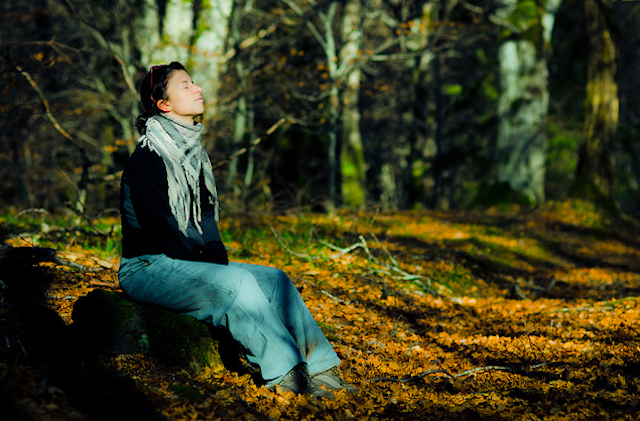
“Change your opinions, keep to your principles; change your leaves, keep intact your roots.” ~Victor Hugo
This week I revisited a favorite national park, some fourteen years after my last visit. Despite the long hiatus, the reason for both trips was the same.
When I last visited in 2000, my goal was to seek out the solitude and beauty of the rainforest, the creeks rushing headlong through shade-dappled gorges, and the vast rocky cliffs overlooking the distant ocean.
I had suffered a recent breakup and wanted to spend some time in nature, in solitude, in a place where I could find and heal my emotional scars.
This time I returned to the same place to spend hours in walking meditation in the forest, trying to understand what had gone wrong with my latest, and longest lasting, relationship.
After the first trip, I then went to spend a week at music festival, where I met a wonderful man, on New Year’s Eve of all times. We shared thirteen years of friendship, love, and companionship, and enjoyed similar activities, such as hiking, camping, and travelling.
We also shared similar values and a similar outlook on life. He’s a hard-working, wise man, and together we raised a blended family of four boys and one girl. We loved nothing better than to sit around a campfire in some national park, sharing a glass of wine and resting after a long hike over a mountain.
But something happened in the last year, and he changed. We went from the couple that everyone thought had the perfect relationship to two people who could not spend five minutes together without arguing.
To this day, I cannot understand what happened. Why had the man I loved gone away and been replaced by this stranger?
It’s been a long and difficult twelve months, and I’ve learned a lot of hard lessons. Perhaps he never did change. Perhaps I was the one who changed him, and he had just gone back to how he was before he met me. Perhaps I will never know.
I don’t know what is going to happen in our future, whether we will ever end up back together again, even though I desperately hope we can rekindle our friendship and love. And of course, most relationship breakdowns cannot be blamed on only one person, and everyone can try and improve themselves, if not to fix their past, then to fix their future.
These are some of the valuable lessons I learned in the forest. I hope they can help others deal with difficult times in their lives.
1. Slow down. Life is not a race.
Despite the fourteen years that had passed, the forest looked exactly the same. Of course it had changed, but imperceptibly, slowly, and incrementally.
On my first walk, I found myself hurrying to get to my destination, getting impatient when I caught up with slower walkers. I would mumble “excuse me” and hurry past with a quick hello, then walk on at an even faster pace so that I would not hear them talking.
I kept looking at my mobile phone, worried that I had no reception and couldn’t check my email or upload a picture to my Facebook page.
After an hour of this, I said to myself, “Stop it!” I was in the forest to learn, to experience, to think. I had no destination and no deadline. I was there for the journey, and for the lesson.
I turned off my mobile phone and slowed down. I stopped whenever I wanted to, whenever I need to rest. I looked at tiny, beautiful flowers and watched a brilliant blue spiny lobster wave his claws at me, furious that I wanted to walk past his territory.
I saw fungi of all shapes and colors, breathed deep the leaf-mold compost fresh-rain smell, and listened to the call of the whip-bird echoing amongst the trees. I walked eight hours a day and was never tired.
I realized that I had spent much of my life planning for some deadline or other, never enjoying the moment, always looking to the finish line. No wonder we had drifted apart. We were both Type A personalities, always impatient, always rushing, always stressed, and always tired.
2. Have a strong foundation.
In the forest the trees grow so tall and wide, some over 50 feet wide and 300 feet tall. But the forest soil is thin and has few nutrients, especially in mountainous areas. How can such huge trees grow so tall?
They grow so huge because they have built strong foundations, vast thick trunks, networks of stilt roots, and wide buttressed roots. They are also part of a system, of the forest itself. In the suburbs, carved out from where forests once grew wild, solitary trees often fall, toppled by the smallest wind, for they have no support from other trees, and their foundation has gone.
If you are going through troubled times, for whatever reason, you need to have a strong foundation. This foundation could be a network of trusted friends and family, a valued work colleague and confidante, a counselor or spiritual teacher, a strong faith in a higher power, a supportive local community, even a loyal pet.
Just as in the forest, we are all part of one human community, and we depend on one another. If you have a strong foundation, you can weather the strongest storms. Branches might break and fall, fires might rage, but you will survive.
3. Disturbance is not bad.
But the forest also needs disturbances. In the forest, disturbances are an integral part of the system, to bring in new life. In a mature forest, the taller trees absorb nearly all the sunlight, so the forest floor is permanently shaded.
Nothing new can grow until something happens, perhaps a lightning strike, or a flash flood, and then one tree falls or drops branches. This creates a gap where the sunlight can pierce the darkness.
Within days, new life takes root; pioneer species make way for the forest giants of the future. And the giant felled tree will rot and provide food and habit and shelter for other species. The forest is not static, and it needs disturbance to bring new life.
Perhaps the problems that you are facing will disturb you and force you to change and to grow, to bring new light into your life.
4. If you can’t get over it, grow around it.
Many of the giant trees have grown around enormous rocks, their roots piercing the very stone, breaking down the rock into new soil. The trees cannot move the rocks, so they just grow around them.
If you have a problem or are suffering a relationship breakdown, grow around it. Do things to break down the problem into new fertile soil.
For example, you might find yourself separated and unemployed, in which case you could go back to school and get some qualifications so that you are no longer dependent on anyone.
Or, through self-analysis or counselling, you might discover some unyielding rock within yourself, such as an unresolved issue from your childhood, which might have contributed to your relationship breakdown; then you can address that problem, and grow around it, so it is no longer the huge obstacle of the past.
In time, even the deepest wounds heal, and the hardest rocks break down; and new life, and a new forest, can grow from the smallest shoot.
Photo by Gregory Tonon
About Heather Shearer
Heather Shearer is a university researcher specializing in environmental behavior; and is a freelance writer and poet. She grew up in the African bush, and loves travelling, hiking and camping. She is currently writing two books, one on habits, and another, on positive environmentalism, based on her Facebook Page, https://www.facebook.com/positiveenvironmentalism.













 Though I run this site, it is not mine. It's ours. It's not about me. It's about us. Your stories and your wisdom are just as meaningful as mine.
Though I run this site, it is not mine. It's ours. It's not about me. It's about us. Your stories and your wisdom are just as meaningful as mine. 